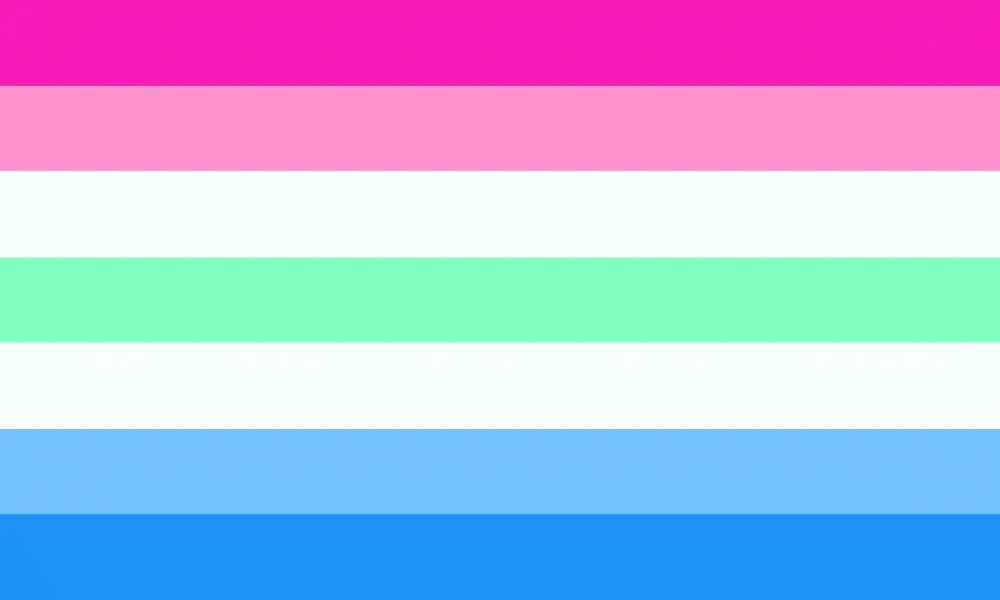Polysexual: Meaning, Identity and History
 Polysexual flag
Polysexual flag
Polysexual often refers to a person who is sexually and romantically attracted to multiple genders but not necessarily attracted to all of them. This means that a polysexual individual will have preferences in terms of their attraction. A polysexual person may or may not be attracted to genderfluid, non-binary people, male or female-aligned people, and or cisgender people.
Polysexuals may be attracted to more than one gender, they may even be attracted to all genders except one gender. They may form relationships with many genders. They may or may not be polyamorous which means being able to form multiple relationships with multiple genders at once.
Table of Content
Terminology
The term comes from the Greek language prefix poly- which means “many”.
According to Urban Dictionary, the word polysexual can be defined as:
“The attraction to more than one gender, with no limit on the gender spectrum. Contrary to popular belief, this has nothing to do with polygamy”
Polysexual people are attracted to more than one gender identity or gender expression, but definitely not all of them. Because of a similar prefix poly- polysexuality is often confused with polyamory. People who identify as polysexual are not necessarily polyamorous. A polysexual individual may have only one partner.
Some people fail to understand polysexuality. It may even be confused with the term polygamy which also has a very similar Greek prefix.
Polysexuality challenges the gender binary notion of sole attraction to cis men and cis women or transgender men and transgender women. It is considered to be one of the most diverse sexual orientations. Similar to a pansexual, a polysexual individual recognizes gender as a spectrum encompassing different gender identities and expressions. Gender is not a factor in their relationship.
History
20th century
The term polysexual has been around for quite some time. In fact, the word polysexual was first used in the 1920s.
Polysexual word got its first mainstream mention decades after its first use. In 1974 Noel Coppage wrote an article about Joni Mitchell and Gordon Lightfoot for Stereo Review. In his piece, the author mentioned polysexual while referencing David Bowie. Though Coppage assumed Bowie’s sexual orientation. The singer never defined himself as a polysexual and seldom spoke of his sexual identity. The author also lumped polysexual, asexual, bisexual, and pansexual in the same category which all have quite a bit of a difference in their definition.
Prior to it being recognized as a sexuality, polysexuality was indeed applied in the context of polyamory. Polysexual folks were assumed to be in sexual and romantic relationships with multiple people. A polysexual relationship meant sexual relations with multiple individuals at once.
Perhaps this is why there is still confusion with other words related to bisexuality and polysexuality. This may also be the reason why the true meaning of polysexuality is often lost in translation. This example may also be behind the lack of representation in the media during the 20th century.
21st century
Today, more polysexual folks are embracing their sexuality. A great example is someone who sees beyond the gender binaries. A polysexual individual is someone who is romantically or sexually attracted to more than one gender, but not all. There has been quite a bit of prominence given to pansexual people especially when celebrities like Miley Cyrus and Tess Holiday shared their pansexual identities with their fans and followers. Polysexual celebrities are a bit harder to come by. That does not mean there is no attention to this identity in the media today.
Recently the fashion world claimed the term polysexuality to itself. World-famous designer Marc Jacobs debuted a polysexual collection that has everything from accessories to outerwear. Indian designers are also exploring genderless and gender-fluid fashion with polysexuality coming to the forefront.
Today being polysexual means being a part of a community. Someone who is polysexual can use many terms to describe their sexual attraction to at least two genders in many different ways.
Differences
Polysexual identity is related to pansexual, bisexual, omnisexual, and other multisexual identities. Polysexuality is considered to be outside the binary gender spectrum. Polysexuals can be of any gender identity or expression.
Polysexuals may be attracted to cisgender, transgender, third gender, agender, genderqueer, two-spirit, intersex people. Polysexuality does not imply that a person is attracted to all genders, but they are attracted to many genders on the spectrum.
According to Bisexual Resources Center, polysexuality can also fall under the bisexuality+ umbrella term.
Bisexual
In some cases, the terms bisexuality and polysexuality may be quite similar. There are some bisexual people who may also identify as polysexual and vice versa when describing their sexual orientation. In most cases, bisexuality suggests a relationship between either the same sex or the opposite. Whether to select bisexuality over polysexuality as an orientation is an individual preference of the person.
Some say bisexual sexual orientation focuses on gender binaries. Others dispute that notion and say bisexuals can often be attracted to all genders. Some bisexual people prefer to use bisexual and polysexual interchangeably. It all depends on how an individual chooses to view their sexual orientation.
Most of the time bisexual people factor in the binary notion of their own gender and the other gender they are attracted to. To some, bisexuality is a form of polysexuality but others view it quite differently. Some folks who identify as polysexual say bisexuality’s meaning focuses too much on the standard binary vision of male and female.
Someone who is polysexual may be attracted to women, men, trans men, trans women, genderfluid, intersex people, and more. Gender plays much less of a role in their attraction than in bisexual one. Polysexuals may be attracted to a variety of genders but not necessarily all genders.
Pansexual
The prefix poly- means many but it does not mean all in terms of attraction. This is where the prefix pan meaning all comes in. A pansexual person will be attracted to any and all genders. The standard definition of this sexuality means that an individual can be in a relationship with multiple genders and see no difference. A polysexual relationship does not mean any gender, it means that a person will potentially enter a relationship with quite a few genders, but not all of them.
When talking about sexual orientations and sexual attraction the best way to understand polysexuality is to remember polysexuals are attracted to many but not all, gender plays a role in their relationship. Pansexuals see no gender in their current or future partner. It is simply not a factor in their attraction. They do not see it in the human being they are attracted to.
Omnisexual
Omnisexuality and pansexuality are very similar sexual orientations. Just like pansexual people, omnisexuals are attracted to all genders but there is a difference.
Omnisexuals unlike gender blind pansexuals have a very distinct gender preference. They know whom they are attracted to and are very aware of their partner’s gender.
Again, omnisexuality means attraction to all genders but with a preference whereas polysexuality means attraction to multiple genders but not necessarily all of them with or without a preference.
Polyamory vs. Polysexuality
There is a common prefix poly here but that is about it. Polyamory and polysexuality have a big difference between them. Polyamory is a relationship orientation, polysexuality is a sexual orientation.
“Someone who is polyamorous has the capacity to love multiple individuals at the same time, and chooses to engage in ethical, honest relationships where engaging with, cultivating, and loving multiple people at once is allowed,” says Gabrielle Kassel (she/her) a queer-inclusive and sex-positive journalist and educator.
Polysexuality encompasses the attraction to many sexualities and genders but not all of them and not necessarily all at once. Polyamory frequently means the desire to be intimate with more than one person at once or not.
Flag and Symbols
The most commonly used polysexual flag during LGBTQ+ pride events has three stripes. The colors of the polysexual flag stand for:
- Pink represents women and female-aligned people
- Green represents non-binary people and gender-fluid individuals
- Blue represents men and male-aligned people
 Polysexual flag
Polysexual flag
There is also an alternate polysexual seven stripe polysexual flag version. It has a very similar meaning to the original polysexual flag but also includes very light pink and blue colors, white as well as light green that stands for transgender polysexual folks. The polysexual flag is intended to be used by polyromantic people as well.
 Alternative polysexual flag
Alternative polysexual flag
Are You Polysexual?
If you feel the label fits your identity well then you may be polysexual. If you are attracted to a variety of genders but not all. If you feel connected to the term polysexual. If you don’t quite feel right with bisexuality. If the terminology feels related to you and you want to be a part of the polysexual community – then you may be polysexual.
There is no orientation that is better than the other. Whether the description of polysexuality fits your sexuality at the present moment is ultimately up to you to decide. The spectrum of sexuality and gender is a spectrum for a reason.
According to Amy Mezulis, a clinical psychologist, many orientations tend to shift over time. In fact, it is quite common for an individual to change the way they label themselves. People evolve and their orientations may evolve with them as they age, discover themselves, their identity and preferences. There is absolutely no issue with changing how you identify your sexual orientation. Polysexuality does not require an explanation, and neither does anyone else.
Pronouns
Polysexuality as a sexual identity and sexual orientation means that people of all genders may identify as polysexual. That means that cisgender, transgender, agender, intersex, nonbinary, and fluid individuals may identify as polysexual. Many polysexual persons use gendered pronouns. A polysexual woman may use pronouns like she/her or they/them. A polysexual trans male may use he/him or they/them pronouns. A polysexual non-binary person may use neutral pronouns like they/them.
There are also individuals who choose to use pronouns of their own. Some people may use pronouns like xe/xem, ze/zir, ee/eem, and more. Never assume someone’s gender and pronouns based on their sexual orientation or expression.
In order to meet accessibility guidelines, it is always best to introduce yourself by stating your pronouns and asking the person about their preferred pronouns.
Challenges Polysexual People Face
There are many myths associated with polysexual folks. Among them of course is the confusion with polyamorous individuals. Being attracted to more than one gender does not mean that a polysexual human will want to be intimate with more than one gender. Their sexual orientation is not connected to their libido.
Some people assume that polysexuals want more attention because they are attracted to more people. Others think they’re just keeping their options open.
There is a common misconception that people who are polysexual cannot form long-term monogamous relationships. That in fact is not true, there are many polysexual persons currently in relationships.
Perhaps one of the biggest challenges is the lack of understanding when it comes to health care services. A large number of people who identify as polysexual do not talk about their sexuality with their health practitioners.
Supporting Polysexual People
Your support for the LGBTQ+ community matters whether you identify as queer, lesbian, gay, trans, bisexual, ally, or anyone else sexuality on the spectrum. Polysexuals need to have an ally on their side.
You can start by showing your support by doing the following:
- Research and provide knowledge on the subject of polysexuality
- Join LGBTQ+ organizations especially those working with polysexual people
- Become an advocate online, comment, and speak on related issues
- Do not be afraid to connect follow polysexual celebrities, speakers, authors on social media
- Talk to friends about polysexuality
Whether you are in a relationship with someone who is polysexual or are friends with someone who identifies as polysexual – your support matters and counts. So do not be afraid to speak up and raise awareness. Be a vocal supporter of the polysexual community.
Share this post:
What do you think?
 Polysexual flag
Polysexual flag


